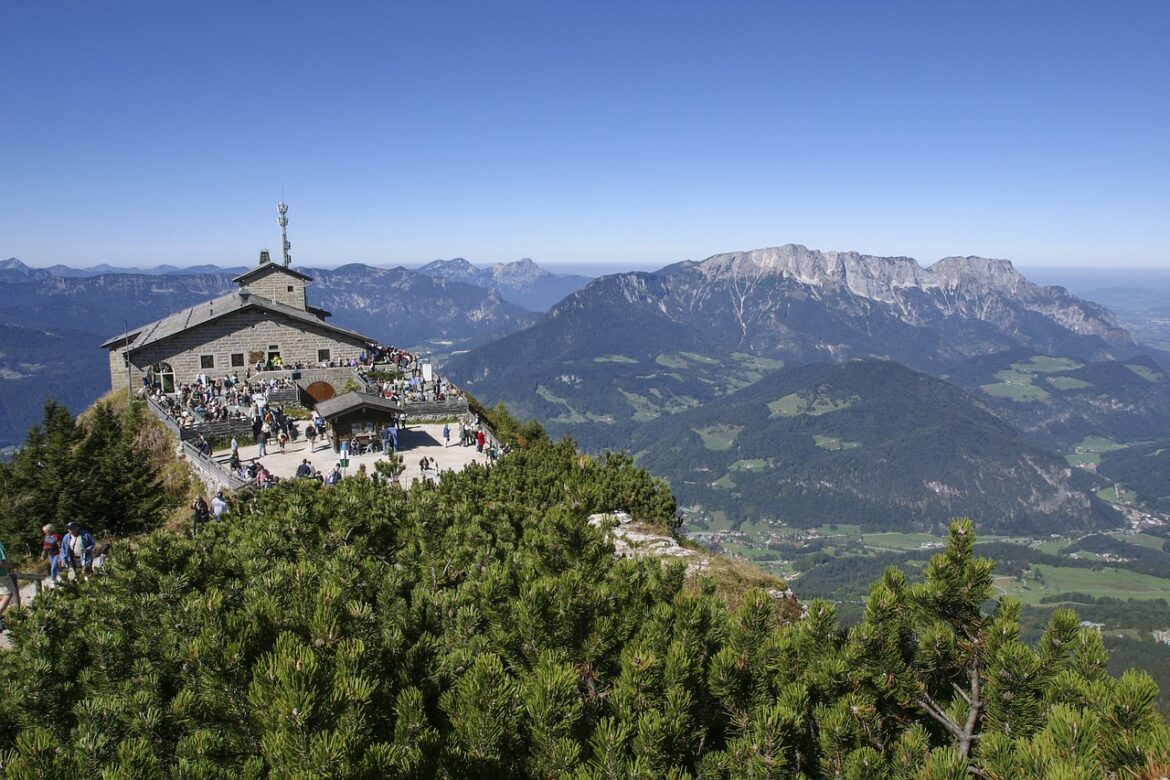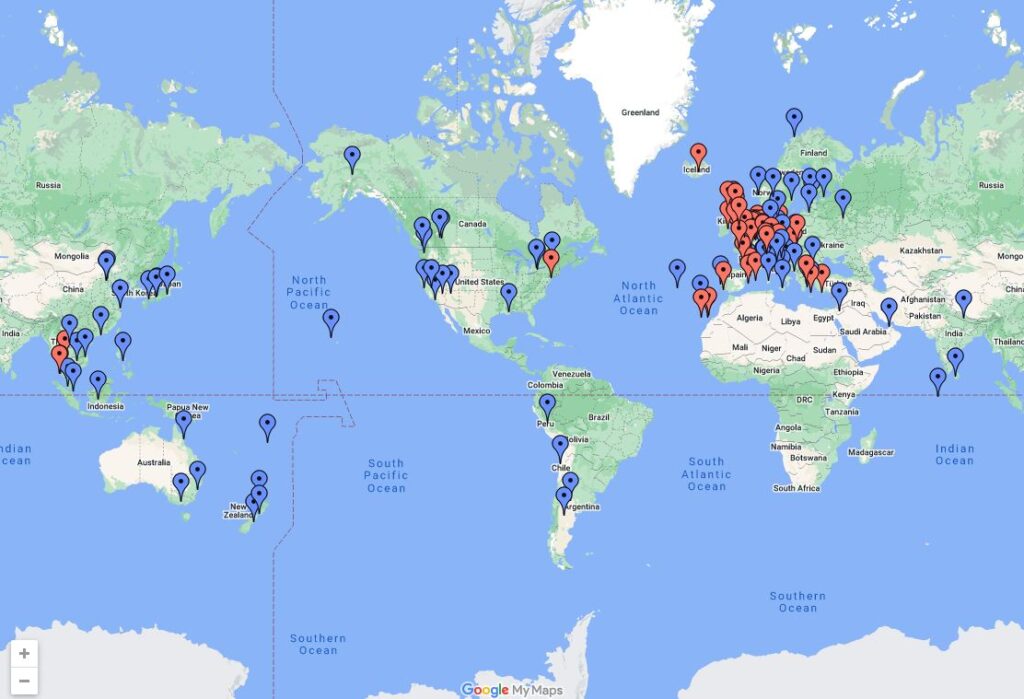Nestled high in the Bavarian Alps, Hitler’s Eagle’s Nest (Kehlsteinhaus), is a symbol of historical significance. Perched atop the Kehlstein mountain at 1,834 meters above sea level in the stunning area of Berchtesgaden. This mountaintop retreat offers breathtaking views, a glimpse into a dark chapter of history, and an unforgettable experience for any traveller! If you’re planning to visit Hitler’s Eagle’s Nest, this guide will take you through everything you need to know. We cover the rich history of the building, how to visit and some practical details to help you make the most of your trip!
History of the Eagle’s Nest
Known by Americans and broader Europeans as the Eagle’s Nest, it is better known in Germany as Kehlsteinhaus. In the area, you will not see any documentation of the Eagle’s Nest. Instead lookout for “Kehlsteinhaus” signs.
The Eagle’s Nest was built in 1938, allegedly as a 50th birthday gift for Hitler by the Nazi Party. It was intended as a retreat and venue for diplomatic meetings; a symbol of the power and reach of the Nazi regime. Despite its strategic importance, Hitler is said to have only visited on 14 documented occasions due to his vertigo. Instead, he spent the majority of his time slightly further down the mountain at Berghof, his Bavarian holiday home, which was heavily bombed and destroyed during WWII.
Hitler’s Eagle’s Nest was constructed over the course of 13 months by 3,000 workers. This included engineers, laborers and craftsmen, who worked in difficult and dangerous conditions to complete construction. Access to the Eagle’s Nest includes a 4 mile road with a 27% gradient that climbs steeply up the mountain. The project cost roughly 30 million Reichsmarks, which in todays money can be roughly estimated to be around £133 million!
Many notable figures were said to have visited and frequented the Eagle’s Nest during Hitler’s reign. This included the likes of Eva Braun (Hitler’s wife), Heinrich Himmler (Head of the SS) and Martin Bormann (Hitler’s private secretary). It’s also widely speculated that Mussolini visited the site. The building remained largely unscathed during the war, making it one of the most intact historical buildings from WWII. Securing this important building was seen as one of the most symbolic and important actions by Allied Forces during the war. This has been depicted in shows such as Band of Brothers, and rightly attracts thousands of visitors each year.
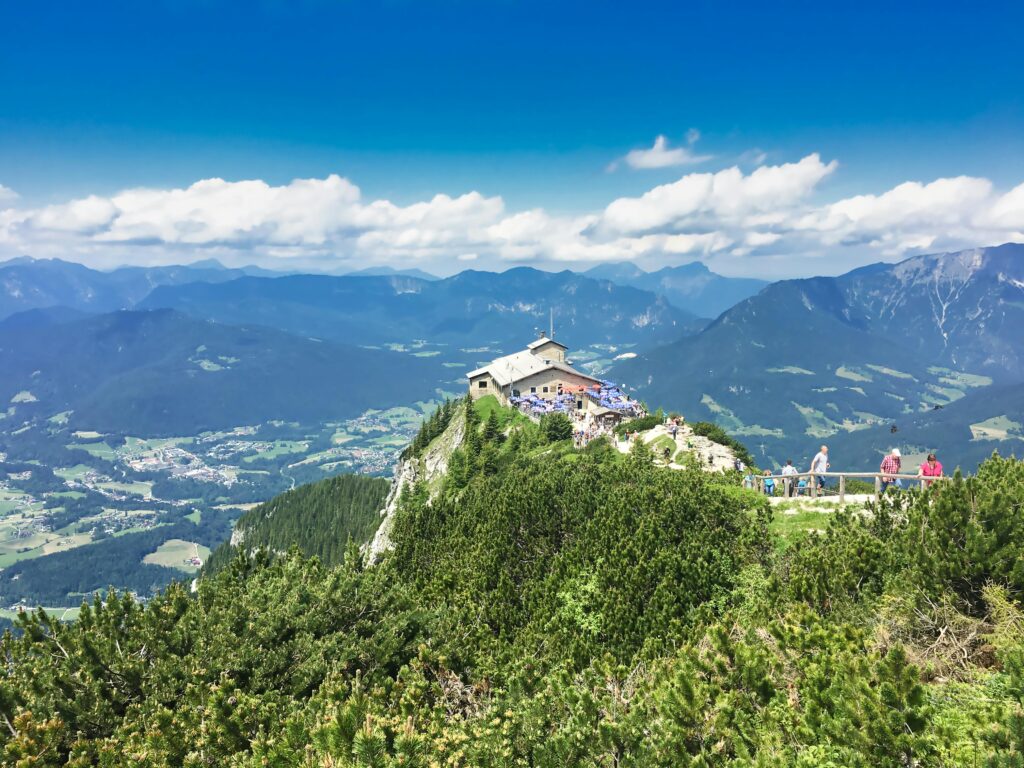
How to visit Hitler’s Eagle’s Nest (Kehlsteinhaus)
Today, the Eagle’s Nest has been converted into a mountaintop restaurant and beer garden. There is some historical documentation, but very little. Regardless, it is still well worth a visit and serves as an important place for reflection and education. It is somewhat humbling and surreal to know you are standing in the exact spots where Hitler himself once stood, and where some of history’s worst crimes were planned.
Eagle’s Nest Opening Hours
A visit to Hitler’s Eagle’s Nest is well worth it for any history enthusiast, traveller or nature lover. However, because of the location’s high altitude, it is very seasonal. During the winter, the site is often covered in a thick layer snow and ice. Therefore you can only reach Kehlsteinhaus from the start of May to the end of October (weather permitting). During that time it is open daily from 8.30am to 4.50pm. For all the latest information, please make sure you check the official website.
Dokumentation Obersalzberg Museum
Your visit to the Eagle’s Nest begins at the Dokumentation Obersalzberg Museum. You do not have to visit this museum, but it is an important starting point for understanding more about the history of the area. The museum offers extensive exhibits about Adolf Hitler’s life, the development of the Obersalzberg complex, and the events leading up to World War II.
The Obersalzberg was a significant Nazi compound, featuring numerous private residences and an elaborate network of bunkers used by top Nazi officials, including Hitler himself. During World War II, the Obersalzberg area was heavily bombed, leading to the destruction of many buildings and extensive damage to the complex. Despite this, several ruins still remain and can be explored as part of the visit. The museum provides valuable context that enhances the experience of visiting the Eagle’s Nest.
Tickets cost about €6 for adults. You can expect to spend between 1 – 2 hours here, depending on your level of interest in the subject. From here, you will then need to catch a bus to visit Kehlsteinhaus.
The only way is up!
To get to the Eagle’s Nest from Obersalzberg, you’ll need to catch a designated bus, which departs every 20-25 minutes close to the Documentation Centre. Unless you choose to hike, this is the only way to reach the summit, as private vehicles are not allowed on the mountain road. The journey takes about 20 minutes in total, along a scenic, winding mountain pass. The trip covers about 7 kilometers, ascending over 800 meters! For the best views, try to grab a seat on the right-hand side of the bus, where you’ll be treated to stunning panoramas of the Berchtesgaden National Park as you make your way up the mountain.
It doesn’t actually cost anything to visit Kehlsteinhaus, but there is a charge for the bus journey. A return bus trip costs about €30 per adult (2024 prices) and also includes a ride in the famous brass elevator. Alternatively, you can hike up to Hitler’s Eagle’s Nest from the Documentation Centre for free! Depending on your level of fitness, the hike would take between 2.5 to 3.5 hours. We’d suggest checking a good hiking app like AllTrails or Komoot for a route. You can also buy one-way bus tickets if you’d rather hike up and bus down (or vice versa).
The views are honestly incredible though! Whichever way you choose to ascend the mountain you won’t be disappointed! If you’re able to flex the days you can visit, try to plan your trip on a clear day for maximum visibility from the top of the mountain. The scenery is unparalleled and is worth the trip to the top!
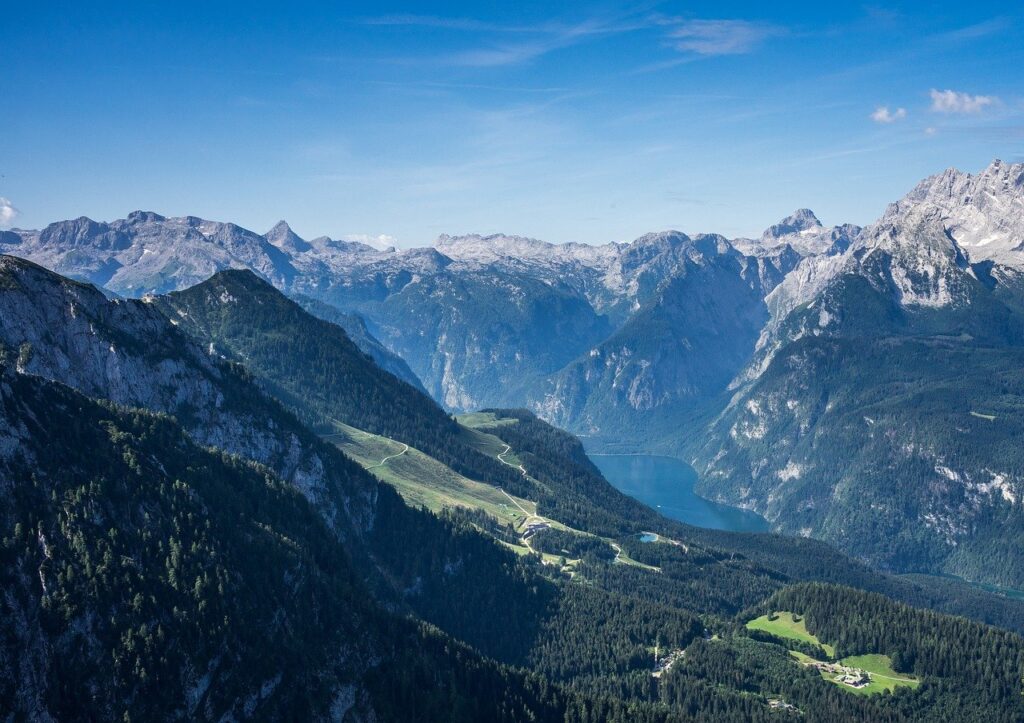
The Golden Elevator
You may have heard rumours that Hitler had a private gold elevator? And the rumours are true! Well sort of. It’s actually brass-panelled but the effect is much the same.
As you hop off the bus, you’ll find yourself at the entrance to a grand, but long and dimly-lit tunnel. At 124 meters long, the tunnel takes you into the heart of the mountain. But at the end of this passage is the famous Golden Elevator, which takes you another 124 meters to the mountaintop where the Eagle’s Nest is perched.
Walking along the tunnel was a bizarre, surreal and eerie experience. It was strange to think that we were walking in the footsteps of where Hitler and his associates had been decades ago. It’s a thought provoking moment. Particularly if you’ve been to the Documentation Centre first.
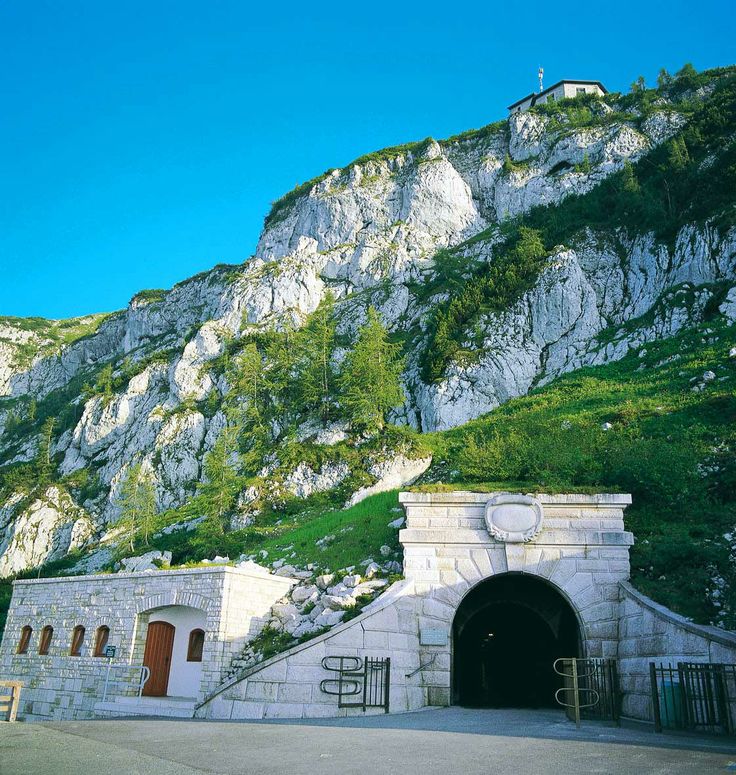
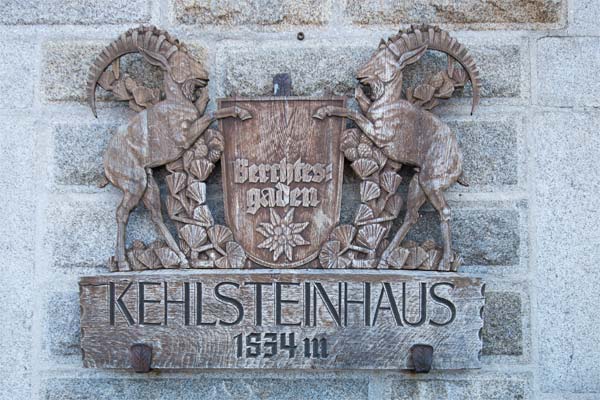
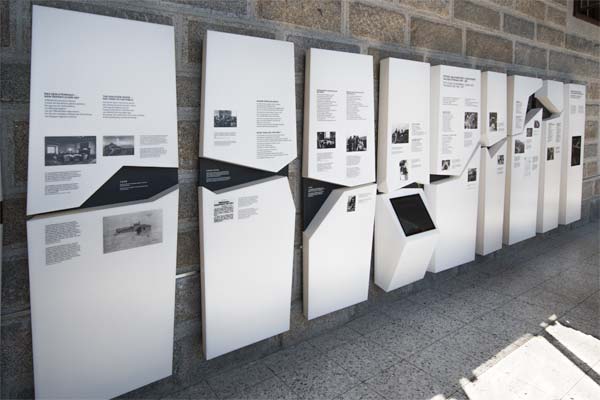
A visit to Hitler’s Eagle’s Nest: What to Expect
The elevator takes you straight into the Eagle’s Nest. Once inside you are free to walk around and explore. Very little of the building is dedicated to its history. But it continues to be a very surreal experience as you try to imagine what life was like inside the Eagle’s Nest during the Nazi regime.
You can walk around the main room, which was used for meetings and social gatherings. At one end, it features a grand fireplace made of red Italian marble. This is said to be a gift to Hitler from Benito Mussolini. There’s also the sunroom which does feature a few information boards where you can learn a little more about the building. It’s worth spending a bit of time here and reading through the information. The sunroom also offers more spectacular views of the surrounding mountains.
As already mentioned, the Eagle’s Nest nowadays is a restaurant and beer garden, so don’t expect too much from your visit. But it’s still well worth a trip for the historical significance alone. Especially if you’re combining it with a visit to the Documentation Centre also.
Enjoy the views
While the interior of Hitler’s Eagle’s Nest is fascinating, the views really do steal the show. Stepping out onto the terrace, you’ll be greeted with a 360-degree panorama around the surrounding mountains. On a clear day, you can see for absolute miles. From the jagged peaks of the Bavarian Alps, to the green valleys far below. There’s also a stunning view of Königssee. On a clear day, you can even see as far as Salzburg!
For a unique dining experience, why not grab something to eat from the beer garden here? You can treat yourself to a slice of Apfelstrudel as you enjoy the incredible views. You can also head up to the mountain’s summit, for that iconic shot of the Eagle’s Nest, with Berchtesgaden National Park in the background. Whether you’re an avid photographer or someone who just loves to be outdors, you’ll find yourself mesmerised by the vistas.
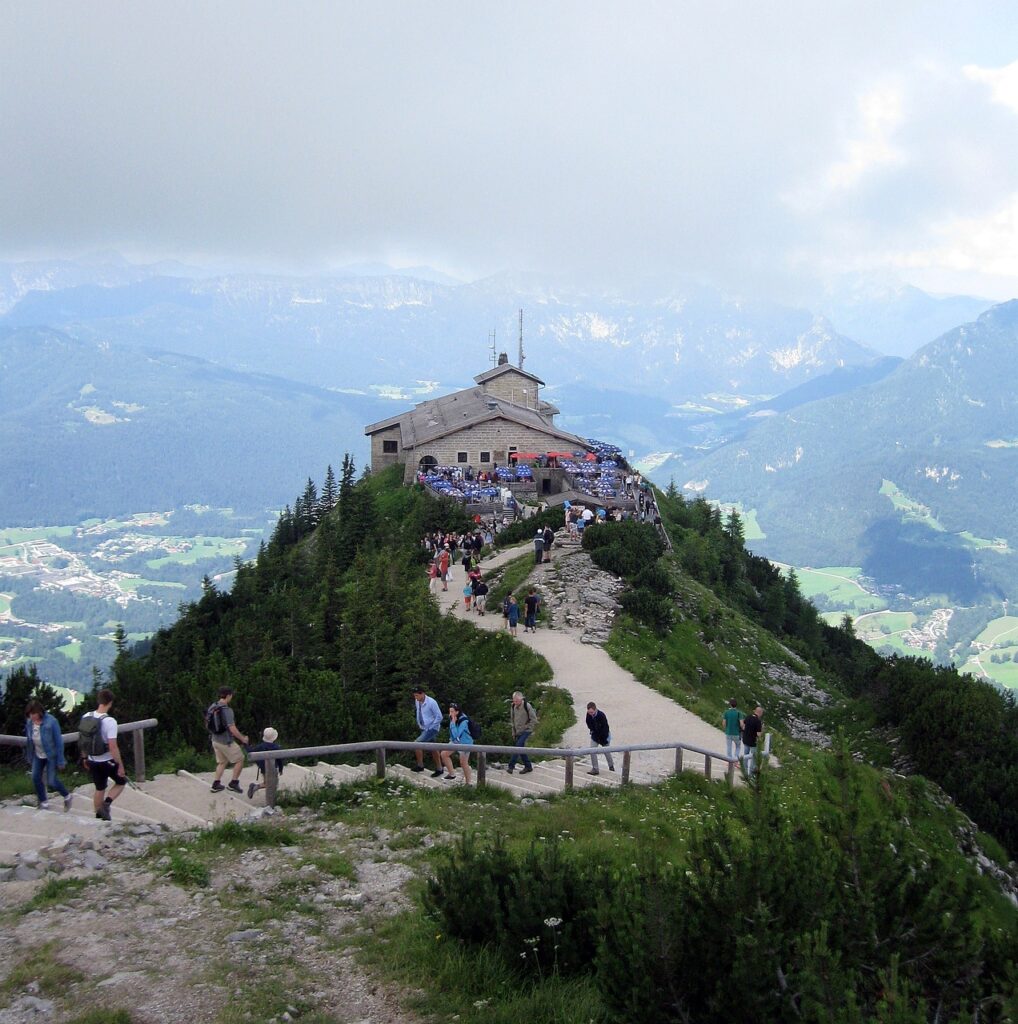
Can I book a tour to visit Hitler’s Eagle’s Nest?
The short answer is yes! We’d recommend that you book a tour to really get the most out of your visit. Particularly as there isn’t any official exhibition or museum at the Eagle’s Nest itself. But this is completely optional and really depends on your interest, your travel plans and how long you have to spend in the area.
Checking somewhere like GetYourGuide is one of your best options. They have loads of different Berchtesgaden and Eagle’s Nest Tours available, covering different styles, durations, activities and locations.
Travelling to visit Kehlsteinhaus: how to get there
To visit the Eagle’s Nest you’ll need to head to the German town of Berchtesgaden. This picturesque town is in the southeastern corner of Bavaria, close to the Austrian border. You’ll love it for its charming alpine setting, traditional Bavarian architecture, and a variety of activities that make it worth exploring in its own right.
Nearest Airports:
Your two main options are:
Salzburg Airport (Austria): Just 30 kilometers (about 19 miles) from Berchtesgaden. This is likely the most convenient airport for many. From here you can hire a car and drive across the border or take the train.
Munich Airport (Germany): Approximately 180 kilometers (about 112 miles) from Berchtesgaden. It’s then a 2 hour drive from the city, or a lengthy train journey.
Travelling by car:
If you prefer the freedom of driving, renting a car is a great option. From Salzburg, you can drive along the B305 road, which takes you through the lush landscapes of the Berchtesgaden Alps. From Munich, take the A8 highway towards Salzburg and then follow the signs to Berchtesgaden. The drive itself is a treat, with sweeping views of mountains, forests, and alpine meadows.
Public Transport:
Train from Salzburg to Berchtesgaden: You can travel from Salzburg to Berchtesgaden in about 1 hour. From Salzburg’s Central Station, take a direct RB to Berchtesgaden. You will pass through Freilassing, but usually a change is not required.
Train from Munich to Berchtesgaden: You can get from Munich to Berchtesgaden by train in around 3 hours. From Munich’s Central Station, take the RB train towards Freilassing. This leg will take roughly 1.5 hours. From Freilassing, take another RB direct to Berchtesgaden. This will take roughly 45 minutes.
Once you arrive in Berchtesgaden, local buses or taxis can take you to the Documentation Center Obersalzberg.
Helpful tip: If you plan to travel Bavaria a little more, you can purchase a Bayern Ticket. This is a regional day pass valid on all regional trains in Bavaria. Buying one of these tickets can be more cost effective than separate tickets.
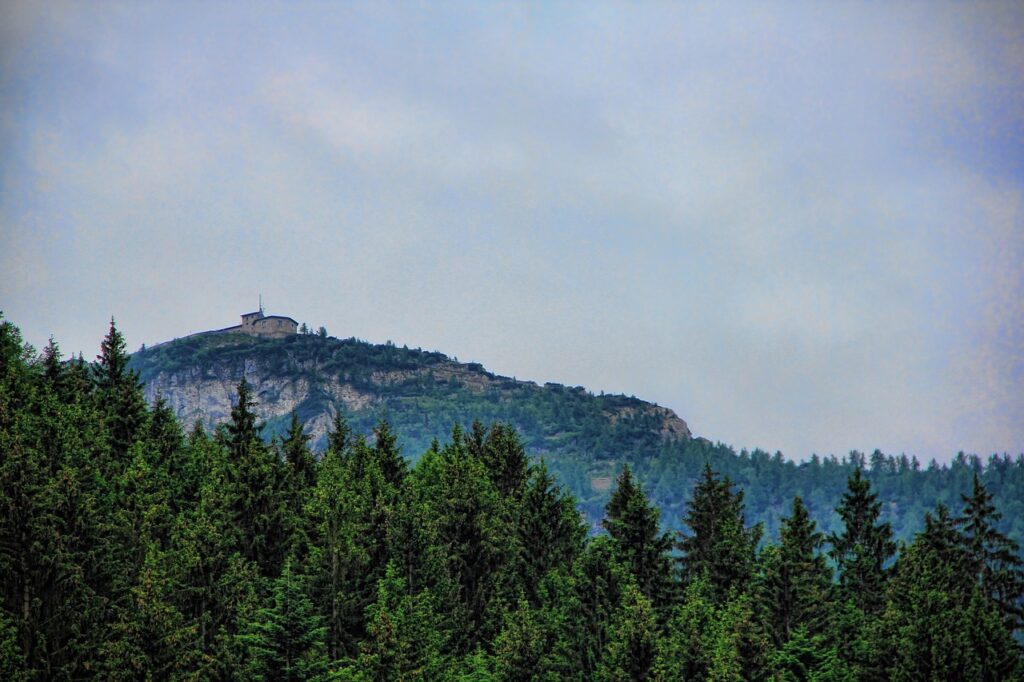
Top tips for visiting Kehlsteinhaus
Best time to visit
Hitler’s Eagle’s Nest is open from mid-May to mid-October, depending on the weather. The best time to visit is during the summer months when the weather is most favourable, and the views most spectacular. However, it’s also the busiest time of year! If you prefer a quieter experience, consider visiting in May or early October. Or try visiting either early morning or late afternoon to avoid the busiest periods.
What to wear
The weather at the top of the mountain can be quite different from the valley below. Even in summer, it can be chilly. It’s worth bringing a jacket and wear layers. Comfortable walking shoes are a must, especially if you plan to hike or explore the surrounding area.
Check the forecast
If you can be flexible with your trip it’s worth checking the weather forecast before your visit. The Eagle’s Nest sits high in the Bavarian Alps, and weather conditions can change quickly. Fog, clouds, or rain can obscure the stunning views.
Be mindful of the history
While the Eagle’s Nest is not a museum as such, please be respectful of the site and mindful of its historical significance.
Explore the beautiful surroundings
While Hitler’s Eagle’s Nest is undoubtedly the highlight of your visit, there’s much more to explore in the surrounding area. Here are a few must-see suggestions:
Berchtesgaden Town: This charming alpine town is a great place to relax after your visit. Stroll through the narrow streets, admire the traditional Bavarian buildings, and stop by one of the local cafes for a coffee and a slice of cake. The town’s historic center is full of character, with shops selling local crafts, and restaurants offering hearty Bavarian cuisine.
Königssee: Just a short drive from Berchtesgaden, Königssee is a stunning alpine lake surrounded by towering cliffs. Take a boat trip to the famous St. Bartholomew’s Church, with its distinctive red domes, or explore the nearby hiking trails.
Rider the Jennerbahn to the summit of Jenner Mountain: ake the Jennerbahn cable car from the base station near Königssee to the summit of Jenner Mountain, standing at 1,874 meters (6,148 feet). The ride itself offers stunning views over the Berchtesgaden Alps, and on clear days, you can even see as far as Salzburg.
Visit the Picturesque Parish Church of St. Sebastian in Ramsau: Just outside of Berchtesgaden is one of the most photographed churches in Germany. Situated beside the crystal-clear waters of the Ramsauer Ache river, with the Reiter Alpe mountains as a backdrop. Visiting the Parish Church of St. Sebastian adds a touch of Bavarian tradition and scenic beauty to your itinerary.
Get in touch
We hope you found this guide to visit Hitler’s Eagle’s Nest helpful! It’s certainly a once in a lifetime experience not to be missed. If you have any questions please leave a comment below, we’d love to hear from you!
If you found our blog helpful, check out our Insta @welovetravel.in – if you give us a follow feel free to drop us a message and say hello 👋
Interested to see where else we’ve adventured to? Check out our Travel Bucket List below 👇

